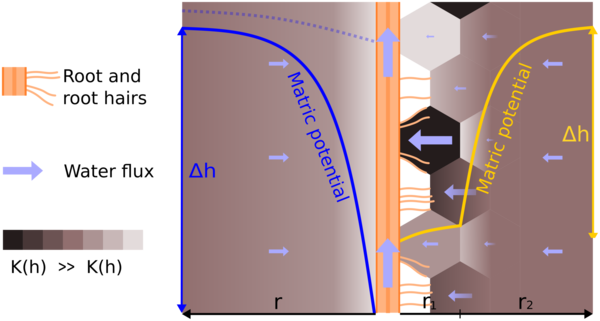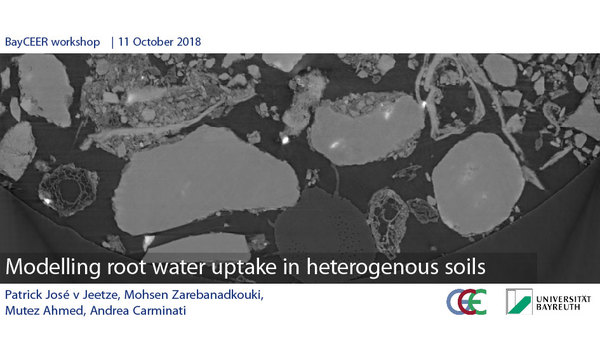Modelling root water uptake in heterogenous soils
O 1.4 in The Skin of the Earth and below: Soil and Water
11.10.2018, 09:55-10:10, H36, NW III
Introduction
Heterogeneity in soil water flow is often treated defining effective properties. Root water uptake (RWU) models commonly use an effective hydraulic conductivity, representative of the bulk soil, to simulate water flow in a notional soil cylinder around the roots. We argue that RWU differs from this effective behaviour: 1) When soil water flow is limited, roots extract water from the most conductive zones, where the fluxes are highest and the depletion is most rapid. For transient flow conditions the emerging relation between flow and gradient in water potential is not properly represented by a single effective conductivity. 2) Roots control their hydraulic contact with the soil via root hairs, mucilage and hydropatterning, thereby altering their capacity to extract water.
Material and Methods
We propose a radial RWU model with two distinct concentric domains. The two domains include a highly conductive domain proximal to the root, corresponding to the most conductive zones where water is extracted, and a distal domain with a hydraulic conductivity equal to the bulk soil (Fig. 1). The radial flux is scaled to the fraction of the root surface that is in contact with highly conductive zones.
Results
Compared to a model with a single domain, in the two-domains model RWU was sustained under higher transpiration rates even with a reduced contact fraction between root and soil. The cost is that once depleted, these highly conductive zones rewet very slowly. This results in an apparent hysteresis in the relationship between root water potential and root water uptake during diurnal cycles in transpiration rate.
Conclusions
The model is capable to include biophysical root-soil interactions (such as root hairs bridging the gap between soil and roots) and their impact on RWU. The proposed model also challenges existing models of water flow in soils and sheds a new light on the puzzling hysteresis that has been long observed in the relation between transpiration and leaf water potential.

Fig. 1: The emerging relation between water flow and potential gradient under drying conditions conceptualized for a standard root water uptake model (blue) and the newly proposed model with two radial domains (yellow). In the two-domains model root water uptake is controlled by the most conductive zones proximal to the root and the fraction of the root surface that is in contact with these zones.
Keywords: root water uptake, root-soil contact, root hairs, soil hydrology, transpiration, xylem potential
Export as iCal:



